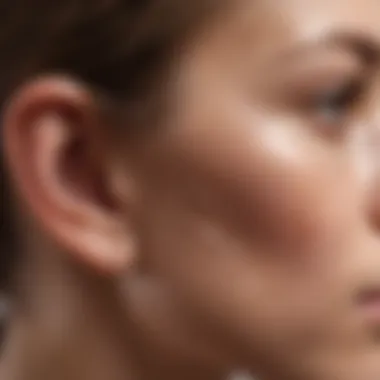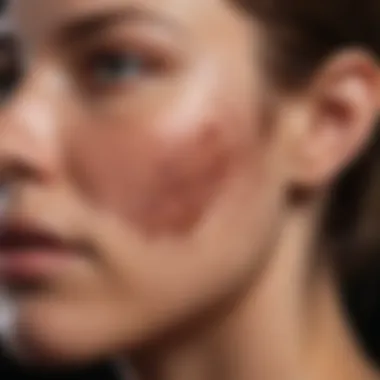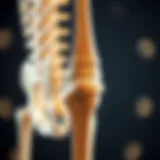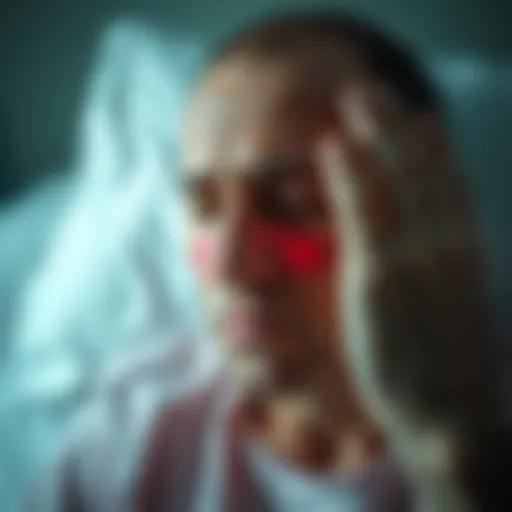Effective Treatments for Keloids on the Ear


Intro
Keloids are an all-too-common nuisance, particularly when they pop up on sensitive areas like the ear. These raised scars, formed from an overproduction of collagen during the healing process, can become a source of discomfort and concern for those affected.
Understanding how keloids form is crucial to developing effective treatment strategies. They often arise after injuries, such as cuts, piercings, or even surgical procedures. The ear, being an area that's frequently subjected to trauma, is especially vulnerable. While keloids aren’t harmful in a medical sense, their appearance can have a significant psychological impact, leading individuals to seek various avenues for treatment.
This is where this article comes into play. We aim to unpack the broad spectrum of methods available for managing keloids on the ear.
Overview of Research Topic
Brief Background and Context
The phenomenon of keloid formation is well documented in dermatological discussions. While the body usually resolves minor injuries with minimal scarring, some individuals experience excessive growth of scar tissue, leading to keloids. Research suggests a combination of genetic predisposition and environmental factors, but the precise mechanisms remain a topic for ongoing inquiry. Such insight lays the groundwork for exploring treatments that range from surgical interventions to alternative therapies.
Importance in Current Scientific Landscape
In recent years, treatment options have expanded significantly. Traditional surgical removal is no longer the only player in the game. Modern methodologies include laser therapy, corticosteroid injections, and even radiotherapy, which have shown promising results. The entry of these innovative approaches is not simply a matter of convenience; it also reflects a deeper understanding of how best to address the multifaceted issue of keloid scars. Drawing attention to these options is imperative, especially among populations that experience high rates of keloid formation.
"Keloids are like unwelcome party crashers; they show up at the worst times and can be tricky to get rid of, but understanding them opens doors to better treatment strategies."
Methodology
Research Design and Approach
The methods for treating keloids on the ear can be categorized into invasive and non-invasive strategies. Each approach has its own set of protocols aimed at managing keloid growth effectively. This section categorizes treatments based on their level of intervention:
- Surgical Treatments: Effective for larger keloids but often have a risk of recurrence.
- Non-Surgical Treatments: These include advanced options like laser therapy, which can minimize scar appearance without invasive procedures.
- Adjunct Therapies: Corticosteroid injections and silicone gel sheeting are commonly used alongside other treatments.
Data Collection Techniques
To keep abreast of the latest techniques and findings, researchers employ a variety of data-gathering methods. Clinical trials, patient surveys, and even anecdotal evidence from patients guide clinicians in selecting the best approach for their needs. Additionally, analyzing case studies contributes to a more nuanced understanding of which treatments yield the best outcomes.
As we delve deeper into each treatment option in the following sections, we will highlight not only their mechanics but also the effectiveness based on current scientific inquiries. Understanding these methods is essential for anyone looking to address keloids from an informed standpoint.
Understanding Keloids
Keloids are not just skin deep; they delve into a realm that intertwines biology, aesthetics, and the emotional aspects of personal appearance. Understanding keloids is crucial for several reasons. First, it lays the groundwork for effective treatments. If one does not grasp how keloids develop or their distinctive characteristics, the path to amelioration may become convoluted. Second, awareness can empower individuals to seek timely help, thus improving quality of life. Lastly, the understanding of keloids serves as a bridge between medical knowledge and practical application, highlighting the importance of a tailored approach based on the specificities of one's situation.
Definition of Keloids
Keloids are essentially thick, raised scars that form due to an overproduction of collagen during the healing process. Unlike normal scars, which become flat and fade over time, keloids grow beyond the original boundary of the skin injury. They can be itchy, tender, or painful, and vary in color from flesh-tone to dark brown or purplish hue. This distinct characteristic makes them a unique form of scarring, demanding specialized management. Understanding this definition means acknowledging that not all scars are created equal; keloids can be seen as a chronic skin condition rather than a mere cosmetic issue.
Causes of Keloid Formation
The formation of keloids can often be a perplexing process. Several factors contribute to their development:
- Genetics: Some folks have a genetic predisposition that makes them more susceptible to keloids. If a family member has keloids, you might have a higher chance of getting them too.
- Type of Injury: Keloids form after various skin injuries including cuts, burns, insect bites, or even acne. In some cases, even a small surgical procedure can trigger keloid formation.
- Skin Tone: There tends to be a higher prevalence in individuals with darker skin tones. The reason behind this is not entirely clear, but it highlights the complexity of keloid formation.
- Age and Hormones: Young adults are more prone to keloids, particularly during puberty. Hormonal changes can play a part in exacerbating the condition.
Each of these causes can combine in unique ways, creating an environment ripe for keloid formation. Understanding these factors helps individuals make informed decisions regarding prevention and treatment.
Symptoms and Appearance
Keloids can present a variety of symptoms that go beyond just their physical appearance. Some common visual characteristics include:
- Raised Texture: Keloids often feel firm or rubbery to the touch.
- Color Variation: The surface may be shiny and can differ in color from the surrounding skin.
- Growth Over Time: They usually grow slowly, sometimes enlarging even years after the initial injury.
In addition to their physical traits, keloids may bring about emotional distress. The visibility of keloids, especially on noticeable areas like the ear, can affect self-esteem and body image. People might find themselves shying away from social situations or feeling self-conscious, leading to frustration and anxiety. The impact of keloids extends beyond skin; it can touch the psyche, hence understanding their symptoms and appearance is crucial for comprehensive care.
"Awareness of keloids is key. Knowing their root causes and characteristics transforms how we approach treatment and management."


By exploring these facets of keloids, individuals are better equipped to navigate their care journey effectively.
Keloids on the Ear: Specific Considerations
When discussing keloids, especially when they appear on the ear, it's crucial to consider the unique aspects related to their manifestation and management. Keloids develop as an overproduction of scar tissue following skin injuries like cuts, piercings, or even acne. However, the ear has certain characteristics that differentiate it from other areas of the body, making treatment and patient experience particularly important to understand.
Locations Prone to Keloids
The ear is a common site for keloids, owing much to its unique anatomy and typical exposure to trauma. Specific areas are more predisposed to keloid formation:
- Lobule: The fleshy part of the ear is especially prone. Piercings, which are often done for aesthetic reasons, can lead to the formation of keloids.
- Helix and Antihelix: These structures, while thinner than the lobule, can still develop keloids due to minor abrasions, sometimes from hats or headphones.
- Scars from surgical procedures: Surgeries like otoplasties may leave scars that could evolve into keloids.
Understanding where keloids are likely to form on the ear helps in anticipating problems before they arise. Identifying these vulnerable areas facilitates better preventative care and informs the choice of treatment options.
Impact on Quality of Life
The presence of keloids on the ear goes well beyond mere aesthetics. They can significantly affect an individual’s quality of life in various ways:
- Self-Esteem Issues: Keloids can lead to self-consciousness, especially if they are prominent or disfiguring. Many individuals report feeling embarrassed or anxious in social situations due to their appearance.
- Physical Discomfort: In some cases, keloids can cause itching, sensitivity, or discomfort, making it bothersome in daily life. Affected individuals may experience pain, particularly if the keloid is touched or irritated.
- Limitations on Activities: Depending on the prominence of the keloid, some individuals might avoid wearing certain styles of clothing or accessories that could draw attention to the scars.
- Psychological Factors: The ongoing struggle with keloids may contribute to distress and anxiety. Some patients find themselves in a cycle of trying treatments without achieving success, leading to frustration.
"Keloids often emerge as a hidden struggle, impacting self-image and emotional well-being in profound ways that are often overlooked in clinical assessments."
Addressing keloids on the ear is not just about removing a scar; it's about enhancing an individual’s overall life experience. By considering these specific factors and their implications, this article aims to provide a holistic perspective on treating this condition.
Diagnosis of Keloids
Diagnosing keloids is a pivotal step in understanding the condition and determining appropriate treatment options. Accurate diagnosis not only facilitates effective management strategies but also aids in educating patients about their condition. Misdiagnosis can lead to inappropriate treatment pathways, which might worsen the situation. Thus, it is essential to approach this topic with significant attention and care.
Clinical Evaluation
During a clinical evaluation, a healthcare professional will start by gathering a detailed history of the patient’s skin ailments. This includes questions regarding previous surgeries, injuries, or skin conditions that could have led to the formation of keloids.
A thorough examination of the lesion itself is vital. Practitioners will typically assess various factors, including:
- Size: Larger dimensions could indicate a more extensive history of keloid formation.
- Color: The color may vary from pink to purplish, presenting vital clues about the keloid’s stage of development.
- Texture: The keloid may feel firm or rubbery, differentiating it from surrounding tissue.
To enhance the precision of their evaluations, doctors may also utilize tools such as dermatoscopes, allowing for a close-up view of the skin characteristics. Keeping in mind the frequent discomfort and psychosocial effects of keloids, healthcare providers often take a compassionate approach during this initial evaluation.
Quote: "Early diagnosis is critical in managing keloids effectively, as it not only promotes prompt care but also minimizes potential scarring and psychological impact."
Additionally, gathering a comprehensive family history can be beneficial, especially since keloid formation may have a genetic predisposition.
Differential Diagnosis
Differential diagnosis involves distinguishing keloids from other conditions that might mimic their appearance. This is crucial due to the similarities between various skin lesions and conditions. Some of the key differential diagnoses include:
- Hypertrophic Scars: Unlike keloids, these typically remain confined to the borders of the original injury and often flatten over time.
- Dermatofibromas: These benign tumors can sometimes appear similar but usually exhibit different characteristics, especially their texture and mobility.
- Cystic Lesions: Certain cysts might have similar aspects due to their raised appearance, making it paramount to differentiate them from keloids.
In some instances, further investigations may be necessary. A biopsy can be performed to examine the tissue under a microscope. This can reveal specific cellular features that confirm the diagnosis of a keloid versus its imitators. By focusing on accurate diagnoses, healthcare professionals can devise a customized treatment plan that alleviates discomfort and promotes healthier skin outcomes.
Implementing these steps thoughtfully and thoroughly ensures that patients are appropriately prepared to tackle the challenges presented by keloids on the ear.
Treating Keloids
Addressing keloids, particularly those that develop on the ear, is essential for both physical comfort and emotional well-being. Keloids not only pose a challenge due to their appearance but can also interfere with daily activities and personal self-esteem. Hence, exploring effective treatment options is vital. The following sections delve into various surgical and non-surgical strategies as well as emerging therapies available for keloid management. By equipping oneself with knowledge about these methods, individuals can make informed decisions that align with their specific needs and treatment goals.
Surgical Options
Surgical methods of treating keloids involve direct intervention aimed at removing the excess scar tissue. These surgeries can be effective, but they also come with some considerations that individuals need to understand.


Excision Techniques
Excision techniques involve the surgical removal of the keloid tissue. This method is a popular choice because it directly targets the problematic tissue, often leading to immediate relief from the symptoms associated with keloids like itching and discomfort. One key characteristic of excision techniques is their potential for a clean, flat scar post-surgery. Some patients favor this method as it can sometimes result in better aesthetic outcomes compared to the keloid itself.
However, this approach is not without its downsides. A unique feature of excision is that while the keloid may be removed effectively, there is a risk of recurrence; that is, the keloid can regrow at the excision site. Additionally, excision may not be suitable for all patients.
Recurrence Rates
Recurrence rates are an important factor to consider when discussing keloid treatments. The rate of recurrence refers to how often keloids return after treatment. In patients undergoing surgical excision, recurrence can be as high as 50% depending on various factors such as size, location, and individual healing tendencies. Understanding recurrence rates is crucial as it can influence a patient's decision on whether to proceed with surgical options.
Moreover, the unique aspect of recurrence rates situates them as a determining factor for follow-up treatment plans. Many practitioners may suggest combining excision with adjunct therapies like steroids or radiation to lessen recurrence risks, adding complexity to the treatment journey.
Non-Surgical Treatments
From injections to pressure therapy, non-surgical treatments offer additional avenues for individuals seeking relief from keloids. These methods can be less invasive and may be preferred by those wary of surgery.
Injections of Steroids
Injections of steroids, such as triamcinolone acetonide, are among the most common non-surgical options to treat keloids. These injections work by reducing inflammation and minimizing the size of the keloid. A key trait of steroid injections is their relatively straightforward application. They can be administered in a clinical setting, and multiple sessions can be scheduled over time to monitor progress.
The unique benefit of steroid injections is their ability to flatten keloids without altering the surrounding healthy tissue. However, the downside is that results can vary from person to person; some might experience significant improvement while others see minimal changes.
Silicone Gel Sheets
Silicone gel sheets have gained traction as an effective non-invasive treatment method, especially for newer keloids or those that are still maturing. One of the hallmarks of silicone gel sheets is their ease of use. These sheets can be applied easily over the keloid and worn for several hours each day.
The primary mechanism of action is that they hydrate the scar tissue and help in softening the keloid's appearance. An advantage is that they are less painful compared to injections or surgeries and can be managed at home. However, they require consistent use over time, and effectiveness may vary, meaning that patience is needed.
Pressure Therapy
Pressure therapy applies controlled pressure to the keloids, which can help flatten them out over time. What makes pressure therapy notable is its non-invasive nature and the possibility of combining it with other treatments. This strategy involves using custom-fitted garments or devices that help maintain steady pressure on the keloid area.
The unique aspect of pressure therapy is that it may not only lessen the size of keloids but can also improve their texture. However, the downside is the commitment required to wear the pressure device consistently, which might be uncomfortable for some patients.
Emerging Therapies
As keloid treatment evolves, new and innovative therapies are becoming more prominent in clinical practice.
Laser Treatment
Laser treatment is one emerging method that shows promise in managing keloids. A defining characteristic of this technique is its precision. Different types of lasers can target scar tissue effectively, leading to a reduction in size, texture, and pigmentation of keloids.
One significant advantage is the minimal downtime compared to more invasive procedures. Patients appreciate that laser therapy requires fewer visits compared to steroids or other treatments. However, its potential drawbacks include the need for multiple sessions and the cost associated with such treatments.
Radiation Therapy
Radiation therapy is another innovative option, often utilized following surgical excision to minimize recurrence rates. The key characteristic here is its strategic approach; it aims to target residual cells left in the area after surgery, potentially preventing keloid regrowth.
The unique feature of radiation therapy is its effectiveness even for larger keloids. However, concerns about the long-term effects of radiation exposure, particularly in younger patients, cannot be overlooked.
Biologic Agents
Research into biologic agents, such as interleukin-10, is emerging as a potential keloid treatment. A notable element of biologic agents is that they aim to work at the molecular level by targeting specific processes that contribute to abnormal tissue growth. This specificity can lead to more tailored treatment regimens.
The uniqueness of biologic agents lies in their relatively novel approach—offering hope for those who haven't responded well to traditional methods. Yet, their use is still largely experimental and comes with an uncertainty that patients should be aware of.
In summary, the treatment landscape for keloids is as diverse as it is evolving. Patients should weigh the pros and cons of each approach and consult with healthcare professionals to create customized management plans tailored to their unique circumstances.
Preventing Keloid Recurrence


Preventing the recurrence of keloids, especially after treatment, holds significant importance for individuals affected by this condition. Keloids can pose a challenge not only due to their physical appearance but also because they may cause discomfort or restrict movement. Thus, understanding how to effectively minimize the chances of keloid development after treatment is essential.
Effective keloid management goes beyond just addressing the visible scar. It involves a comprehensive approach that incorporates both immediate post-treatment care and long-term lifestyle adjustments. Establishing effective prevention strategies can help reduce the likelihood of keloids returning and enhance the overall outcomes of treatment.
Post-Treatment Care
After undergoing treatment for keloids, following proper post-treatment care is critical in preventing recurrence. Patients should take a proactive stance in managing their recovery phase. Here are key aspects to consider:
- Keep the Area Clean: Maintaining hygiene is paramount to prevent infection, which may exacerbate the issue. Patients should gently cleanse the treated area as recommended by their healthcare provider.
- Moisturize the Scar: Using silicone gel sheets or topical creams can help keep the scar hydrated. This is important as well-hydrated scars tend to heal better and present lower recurrence rates.
- Avoid Excessive Sun Exposure: UV radiation can alter skin structure and contribute to darkening or worsening of keloids. It’s wise to use sunblock or cover the area to protect it from sun damage.
- Follow Up with Healthcare Providers: Regular check-ups with dermatologists or plastic surgeons can help monitor the healing process and address any issues before they become significant.
"Prevention is better than cure." This adage rings especially true when it comes to managing keloids and their recurrence.
By adhering to prescribed care regimes, patients can significantly curtail the odds of the keloids returning.
Lifestyle Modifications
Making specific lifestyle modifications can further bolster efforts to prevent keloid recurrence. A few beneficial changes include:
- Healthy Diet: Maintaining a balanced diet rich in vitamins and minerals fosters overall healing. Foods packed with Vitamin C and E can be particularly advantageous for skin health. Incorporating antioxidants can aid in the skin's recovery and resilience.
- Stress Management: Emotional and physical stress may impact healing. Engaging in stress-relieving activities, such as yoga or meditation, can promote recovery and lower the risks associated with keloid return.
- Limit Skin Trauma: It’s crucial to avoid any unnecessary skin trauma, as even seemingly minor injuries can trigger keloid formation. This includes refraining from unnecessary piercings or tattoos, particularly in areas previously affected by keloids.
- Educate Yourself: Being aware of the body’s response to injuries can empower individuals. Knowledge about proper wound care and the implications of scars can guide better decision-making in handling future injuries.
Taking such proactive measures can play a pivotal role in minimizing the chances of keloid recurrence. Understanding the interplay between post-treatment care and lifestyle adjustments is key to developing a comprehensive prevention strategy.
Coping with Keloids
Navigating life with keloids, especially when they are on the ear, brings a unique set of challenges. Coping with these raised scars goes beyond physical treatments and delves into emotional and social dimensions. The way individuals manage their feelings and the impact keloids have on daily life is crucial for overall well-being.
Psychological Impact
Keloids can often feel like more than just a cosmetic concern. The psychological aspects are significant. Many individuals who develop keloids experience self-consciousness and anxiety about their appearance. This can lead to avoidance of social situations or reluctance to participate in activities that put their scars in the spotlight, such as swimming or attending events where dress codes may reveal the keloids.
Research reveals that visible skin conditions like keloids can lead to issues with self-esteem. The link between physical appearance and self-worth is well-established, and keloids can act as a barrier to self-acceptance for some. The emotional toll isn’t a small feather to brush off; it can lead to conditions like depression or social anxiety if left unaddressed. Moreover, people with keloids may face stigma or misunderstanding from others, further exacerbating these feelings. It’s a tough road, navigating the balance between self-advocacy and wearing one’s scars like evidence of resilience.
Support Groups and Resources
Finding the right support can make all the difference. Support groups offer individuals a space to share experiences, insights, and coping strategies. Organizations dedicated to skin conditions often provide forums where people can connect with others who understand their struggles.
Online platforms like Reddit host various threads focused on keloids, allowing individuals to share tips, treatment latest trends, and emotional coping strategies. Social media platforms, particularly Facebook, can also be great sources of community support, where closed groups can provide a safe environment for discussing sensitive issues related to living with keloids.
Some key benefits of engaging with support networks include:
- Shared Experiences: Hearing from those who have been down similar paths can not only validate feelings but also inspire.
- Information Exchange: Members often share valuable knowledge about treatments and coping mechanisms.
- Community Building: Being part of a group diminishes feelings of isolation.
Leading organizations focused on dermatology often produce educational materials that provide insights into dealing with the emotional impacts of keloids. Armed with knowledge and a strong support system, individuals can better navigate their journey, ultimately helping them to cope with keloids in a more balanced way.
"Support doesn’t mean you’ve failed; it means you’re strong enough to seek help when the going gets tough."
End
The discussion of effective methods for treating keloids, particularly on the ear, underscores a vital element in dermatological health. Keloids are more than just unsightly protrusions; they can profoundly affect an individual’s confidence and overall quality of life. Thus, addressing this condition with appropriate treatment is essential.
The Importance of Treatment
Treating keloids can lead to significant improvements in several areas. First and foremost, timely intervention often aids in reducing the size and visibility of the keloid. Options such as surgical excision, steroid injections, and silicone gel sheets can help flatten and soften the growth. Efficient treatment not only addresses cosmetic concerns but also assists in alleviating discomfort that some individuals may experience due to keloids. People having keloids on the ear may face irritation from earrings or even hair manipulations, making effective treatment all the more critical.
Moreover, addressing this condition helps foster a sense of ownership over one's body. Many who struggle with keloids on their ears report feelings of frustration and helplessness. By actively engaging in their treatment plans, individuals regain a sense of control, which can prove psychologically beneficial. It also opens avenues for discussions that highlight the emotional impacts of skin conditions, offering support and understanding to those affected.
Further Research Directions
Although we’ve seen a variety of treatments for keloids, the research landscape remains ripe for exploration. One promising area is the investigation of biologic agents. These treatments target the pathways involved in keloid formation, potentially offering more effective management options than traditional methods. It raises the question of why certain individuals are predisposed to keloids and whether genetic factors play a role.
Additionally, more studies could be beneficial in understanding the long-term efficacy of newer treatments like laser therapy. The variations in keloid response across different demographics also merit attention. For instance, examining why some ethnic groups experience higher instances of keloids could direct tailored treatment strategies.
"Research offers the key to unlocking innovative solutions that could redefine keloid management entirely."
In summary, the goal is clear: to enhance treatment protocols, increase awareness, and ultimately improve the lives of those affected by keloids. As we delve deeper into understanding the mechanisms of keloid formation, the potential for more refined and effective therapies looks promising.



